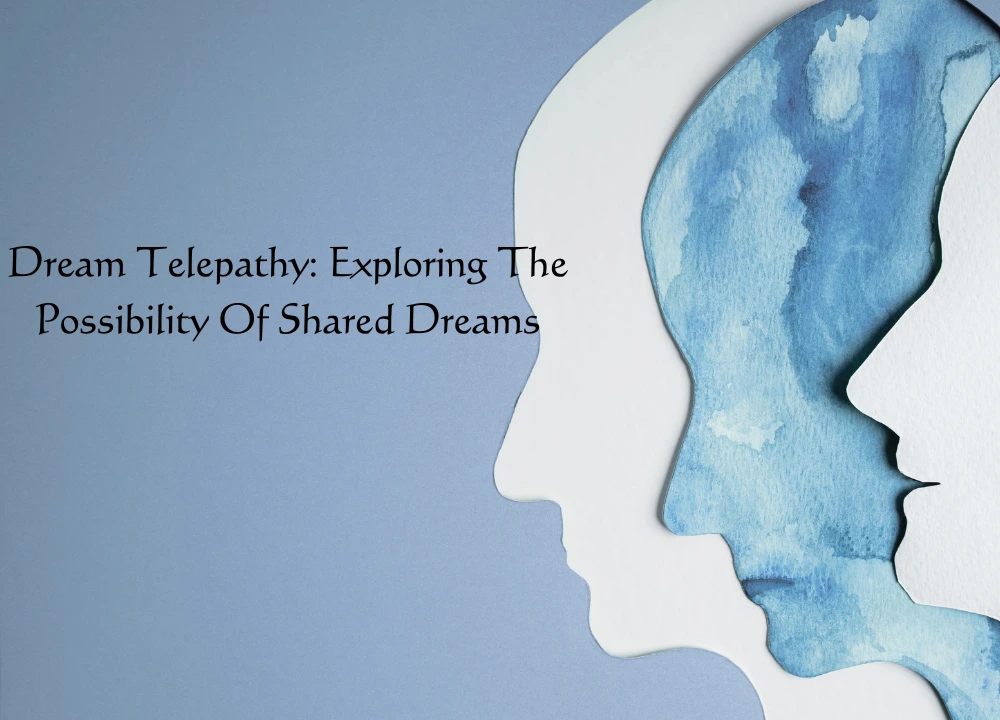Dream Telepathy: Exploring The Possibility Of Shared Dreams

Dream telepathy, also known as telepathic dreaming or psi dreaming, refers to the phenomenon in which individuals can communicate with each other through dreams, bypassing traditional methods of verbal or written communication. It suggests the ability to transmit thoughts, emotions, and information from one person to another during the dream state.
The premise behind dream telepathy is that people can communicate with one another subconsciously and that awareness exists outside of the physical body. It implies that communication can happen while you’re sleeping when your mind is more open to experiencing things that aren’t physical.
When someone projects their thoughts or feelings into the dream world, another person—often called the receiver—can detect and decipher these signals. There are many ways to communicate, such as through vivid images, symbols, feelings, or face-to-face interactions. Numerous investigations have been made into the nature and existence of dream telepathy. These investigations examine the parallels and links between the dream experiences of the sender and recipient, frequently using subjects which assert to have had telepathic dreams.
Though research into dream telepathy is still in its infancy, some theories contend that it may be made possible by many elements, including strong emotional bonds between people, enhanced states of consciousness while sleeping, and the subconscious processing of information. It is significant to highlight that scientific research and discussion on dream telepathy continue.
According to sceptics, the experiences of dream telepathy can be explained by coincidences, selective memory, or unconsciously absorbed cues from waking life. However, those who believe in dream telepathy are still researching the phenomenon to offer concrete proof and a deeper comprehension of this fascinating facet of human awareness.
The History of Dream Telepathy Research
The History of dream telepathy research late 19th and early 20th centuries when interest in parapsychology and psychic phenomena began to emerge. Here are some key milestones in the History of dream telepathy research:
Society for Psychical Research (SPR):
The SPR, founded in London in 1882, played a significant role in investigating paranormal phenomena, including telepathy and dreams. Prominent figures like Frederic W.H. Myers and Sigmund Freud were associated with the SPR and explored the concept of telepathic dreams.
Frederic W.H. Myers:
Myers, a founding member of the SPR, conducted early research on telepathic dreams. In the book “Human Personality and Its Survival of Bodily Death” (1903), he proposed the idea of telepathic interactions during sleep and analyzed several anecdotal accounts of dream telepathy.
Louisa E. Rhine:
In the mid-20th century, parapsychologist Louisa E. Rhine, along with her husband J.B. Rhine, conducted extensive research on extrasensory perception (ESP), including dream telepathy. They collected data from thousands of dream reports and attempted to quantify the occurrence of telepathic dreams.
Dream Telepathy Experiments at Maimonides Medical Center:
In the 1960s, Dr Montague Ullman, a psychiatrist, and Stanley Krippner, a psychologist, conducted a series of dream telepathy experiments at the Maimonides Medical Center in Brooklyn, New York. They used a “sender-receiver” model where one participant would attempt to transmit a target image to a sleeping participant, who would then report their dream experiences. Their findings suggested a correlation between the dream content of the receiver and the target image.
Sleep Laboratories and Quantitative Studies:
In the second half of the 20th century, scientists began conducting quantitative studies on dream telepathy with the development of sleep laboratories and more sophisticated research methodologies. These studies involved statistical analysis of dream content and comparisons between the dreams of multiple participants in identifying potential telepathic connections.
It is important to note that while dream telepathy has been a subject of interest and research, the scientific community remains divided on the validity and interpretation of the findings. The field of parapsychology continues to explore dream telepathy, employing rigorous methodologies and statistical analyses to understand this intriguing phenomenon better.
How does dream telepathy work?
The precise mechanisms underlying dream telepathy are not yet fully understood, and scientific research in this area is ongoing. However, several theories have been proposed to explain how dream telepathy might work:
Non-local Consciousness:
One theory suggests that consciousness extends beyond the physical body and operates on a non-local level. In this view, dream telepathy occurs through the interaction of consciousness fields, allowing thoughts and information to be transmitted between individuals during the dream state.
Subconscious Communication:
Dreams are thought to originate from the subconscious mind, which processes and integrates information outside of our conscious awareness. It is possible that during sleep, the subconscious minds of individuals can communicate with each other, exchanging thoughts, emotions, and symbols that manifest as dream experiences.
Emotional Connection and Intention:
Strong emotional bonds or deep connections between individuals may play a role in facilitating dream telepathy. It is believed that the sender’s emotional energy and intention can influence the receiver’s dream experiences, enabling the transmission of thoughts or information.
Quantum Entanglement:
Some theories draw upon principles from quantum physics, suggesting that dream telepathy might involve quantum entanglement between individuals. Quantum entanglement is the happening where two particles become linked in such a way that one particle’s state affects the other’s state, regardless of the distance between them. It is hypothesized that consciousness or information transfer in dream telepathy could operate through similar quantum processes.
It’s important to note that these theories are speculative and not yet scientifically proven. The study of dream telepathy is complex and requires further research, including controlled experiments and advancements in our understanding of consciousness and the nature of dreams.
How to improve your dream telepathic ability?
While the existence of dream telepathy and methods to improve it are still subjects of ongoing research and debate, there are some practices that individuals interested in exploring their dream telepathic potential can consider. Here are a few suggestions:
Dream Journaling:
To remember your dreams, keep a journal by your bed and write them down as soon as you wake up. Regularly recording your dreams helps you become more attuned to your dream experiences and can improve dream recall over time.
Intent and Affirmations:
Set the intention to have telepathic dreams and affirm your desire to communicate with others through dreams before going to sleep. This practice can help focus your mind and create a receptive state for dream telepathy.
Visualization and Mental Imagery:
Before sleep, visualize yourself engaging in telepathic communication with another person. Imagine sending and receiving thoughts, emotions, or symbols. This practice may help to develop a stronger connection and intention for dream telepathy.
Partner Exercises:
If you have a willing partner, you can engage in dream telepathy exercises together. Choose a simple image or symbol as a target and agree to focus on it before sleep. Upon waking, compare your dream experiences to see if any telepathic connections or similarities emerge.
Meditation and Mindfulness:
Cultivating a regular meditation or mindfulness practice can enhance self-awareness, focus, and receptivity to subtle experiences. These practices may indirectly improve dream telepathy by developing your overall consciousness and intuition.
Emotional Bond and Connection:
Foster a strong emotional connection and bond with the person you wish to have telepathic dreams with. Deep emotional connections may enhance the likelihood of telepathic experiences during sleep.
Remember, while these practices may enhance your overall dream experiences and potentially facilitate dream telepathy, the nature of dream telepathy itself is still speculative. It’s important to approach these practices with an open and curious mindset, understanding that individual experiences may vary.
Avenues of further research in Dream Telepathy
Dream telepathy continues to be a fascinating and relatively unexplored area of research. Here are some avenues for further investigation in the field of dream telepathy:
Controlled Laboratory Studies:
Conduct more controlled laboratory studies using rigorous methodologies to explore dream telepathy. These studies could involve larger sample sizes, standardized protocols, and the use of advanced technology, such as brain imaging techniques, to gain insights into the neural correlates of dream telepathy.
Quantitative Analysis of Dream Content:
Analyze dream content in telepathic dream pairs to identify common themes, symbols, or imagery that could suggest telepathic connections. Utilize established dream analysis techniques, such as content analysis and coding systems, to objectively quantify and compare dream content.
Emotional Factors:
Investigate the role of emotional factors in dream telepathy. Explore how the strength of emotional bonds between individuals influences the likelihood and quality of telepathic dream experiences. Examine the impact of emotional energy, empathy, and intention on dream telepathy.
Neurobiological Mechanisms:
Explore the neurobiological mechanisms that might lie under dream telepathy. Investigate brain regions and networks involved in telepathic experiences during sleep and explore potential similarities or differences with other forms of communication and information processing in the brain.
Relationship to Other Psychic Phenomena:
Explore the relationship between dream telepathy and other psychic phenomena, such as telepathy in waking states, precognition, or clairvoyance. Investigate potential links, overlaps, or synergies between these different forms of psychic experiences.
Technology-Assisted Dream Telepathy:
Investigate the use of technological tools to enhance or facilitate dream telepathy. Explore the potential of neurofeedback, brain-computer interfaces, or other devices to improve communication and interaction during dream states.
Long-Distance Dream Telepathy:
Investigate long-distance dream telepathy, where individuals attempt to establish telepathic connections across significant geographical distances. Explore the influence of physical distance, time zone differences, and cultural factors on the occurrence and quality of dream telepathy.
By researching further, scientists can deepen our insight into dream telepathy and its implications for consciousness, communication, and reality.
Conclusion
In conclusion, dream telepathy remains an intriguing and enigmatic phenomenon that continues to captivate the interest of both researchers and individuals curious about the limits of human consciousness. By delving deeper into these areas, scientists can contribute to expanding our understanding of dream telepathy and its implications for our comprehension of consciousness, communication, and the nature of reality.









